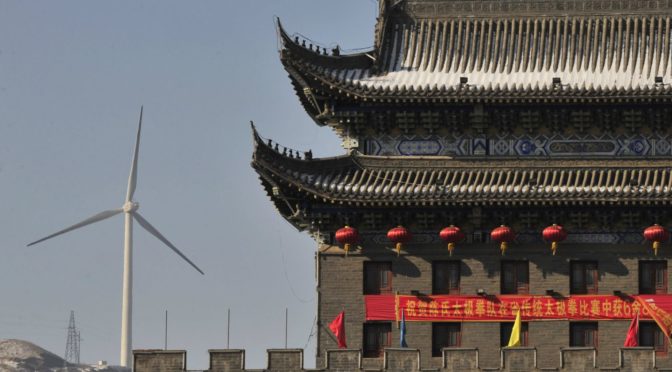China’s installed wind energy capacity has increased yet again, growing 13% in the first quarter over the same time a year earlier, bringing the country’s cumulative capacity up to 151 gigawatts.
China had 151 million kilowatts of installed wind power capacity as of the end of the first quarter, up 13 percent year on year.
Provinces of Qinghai, Shaanxi, Henan and Hebei increased the most in wind power capacity during the first three months, the NEA said in an official statement.
Wind power facilities generated 68.7 billion kilowatt hours of electricity in the first quarter, 26 percent more than in the same period in 2016.
Due to distribution of wind resources and an imperfect grid system, 13.5 billion kilowatt hours of wind power was wasted in the first quarter, down 5.7 billion kilowatt hours from the same period last year.
China’s energy mix is dominated by coal. Power consumption rose 6.9 percent year on year in the first three quarters of the year, 3.7 percentage points higher than the same period last year, official data showed.
Thanks to China’s push for renewable energy, the country’s energy intensity, the amount of energy consumed per unit of GDP, decreased 3.8 percent year-on-year in the first quarter, the National Bureau of Statistics said earlier this month.
China’s total energy consumption will be capped at 5 billion tonnes of coal equivalent by 2020, according to a government plan for 2016 to 2020. This will amount to a 15 percent reduction of energy use per unit of GDP by 2020.
Over 54 gigawatts (GW) of wind power were installed in 2016 and cumulative capacity grew by more than 12 percent to hit 486.8 GW, according to a new report from global trade association, the Global Wind Energy Council (GWEC).
Released on Tuesday, the GWEC’s Global Wind Report: Annual Market Update forecasts nearly 60 GW of wind installations this year, with cumulative installed capacity seen reaching more than 800 GW by the end of 2021.
The GWEC said that Asia would lead growth, with China – which installed 23 GW in 2016 – leading all markets.
The report further outlined that the 2016 market had not met expectations set by the GWEC in early 2016. This was due to several reasons, including China installing “only” 23 GW in 2016 and smaller-than-expected markets in Mexico, Brazil, Canada and Africa.
The majority of these issues were seen as cyclical, the GWEC said, and it expected the market to pick up this year.
“Wind power is now successfully competing with heavily subsidized incumbents across the globe, building new industries, creating hundreds of thousands of jobs and leading the way towards a clean energy future,” Steve Sawyer, GWEC secretary general, said in a statement.
“We are well into a period of disruptive change, moving away from power systems centered on a few large, polluting plants towards markets increasingly dominated by a range of widely distributed renewable energy sources,” Sawyer added.
Wind energy is becoming an increasingly important source of power, with the International Energy Agency stating it is “developing towards a mainstream, competitive and reliable power technology.”
Looking forward, the GWEC said that Africa was set to have a “big year in 2017” while the Australian market was due to “come roaring back with a pipeline of projects” to be built over the coming years.
“Overall, we have a lot of confidence in the wind power market going forward, as the technology continues to improve, prices continue to go down and the call for clean, renewable power to reduce emissions, clean our air and create new jobs and new industries only gets stronger with each passing year,” Sawyer added.

